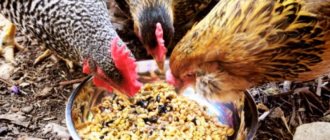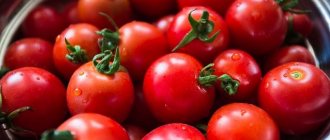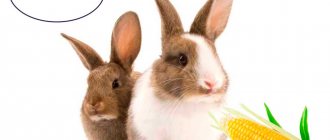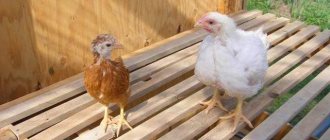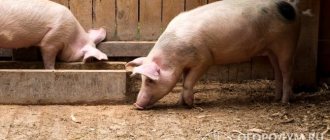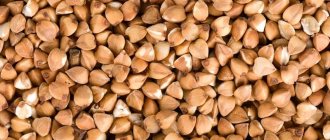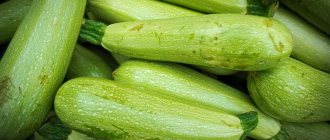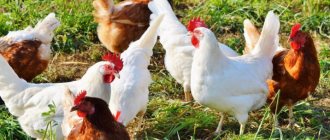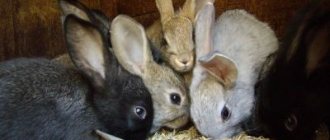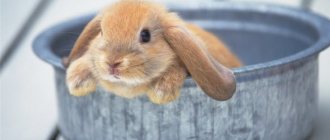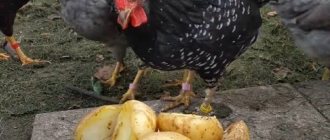Owners of rabbit farms are interested in the question of whether rabbits can eat peas. Many people grow this crop in their gardens; it can be a good help for farmers. From this article, readers will learn at what age it is allowed to introduce peas into the diet of long-eared animals, whether tops and pods can be given, and how to properly feed animals with such food.
Feeding the rabbit peas
Can rabbits be given peas?
Legumes, which include peas, are considered valuable food products for animals. They contain many useful substances, especially complete protein, and are easily absorbed by the body. True, only with reasonable use and preliminary preparation for feeding.
In the diet for rabbits, peas are present in mixed feed, self-prepared feed mixtures and as a separate food. Livestock can be safely fed green mass, pods and mature grain.
Animals accustomed to such food readily eat it at any age. However, it happens that adult rabbits who have not previously eaten it can remain quite indifferent to it. In this case, it needs to be added little by little to the regular food until the animals taste it.
Composition of a proper diet
Before giving legumes, including peas, to rabbits, it is necessary to know not only the genetic features of the structure of the animal’s body, but also the composition of the product. This is required in order to assess the benefits or harm that a rabbit may receive when eating a certain type of food.
Rabbit breeding has long been characterized by fairly stringent requirements for food standards, balance and composition. In order for animals to grow successfully, be less exposed to various diseases and have high sexual productivity, their diet must be varied. This is the main rule in feeding rabbits. The combination of green grass, grain, root vegetables, fruits, legumes, mixed feed, hay, silage, as well as various vitamin supplements, is the key to the correct and effective cultivation of these animals.
Advice! Most food for rabbits must have a coarse structure, which is necessary for grinding down constantly growing teeth.
Animals constantly have to chew on something, and in addition to their main food, they are given thin branches of some trees, such as cherry or acacia. Another important point in feeding is the drying of succulent grass (at least a day in a dark place) and other types of food that contain a lot of liquid. In addition, when feeding roughage, you should monitor the purity of the water for the animals, which is given and changed every day. If you neglect this rule of care, you can get negative consequences in the form of the development of intestinal infections.
Benefits of peas for rabbits
Pea grain is, first of all, a product with a high protein content. According to this indicator, it occupies one of the first places among concentrates in livestock farming. Its introduction into the diet of pets allows, without increasing the norm, to increase the nutritional value of feed and satisfy the animal’s need for protein.
Rabbits need a high protein diet at different times in their lives. So, it will be useful for small rabbits and young animals, promoting the growth and development of muscle mass of animals. Rabbit breeders have long noticed that animals fed with peas always look larger and heavier than their peers of the same breed.
The need for protein also increases in females during the period of bearing and then feeding offspring. The inclusion of such feeding in the diet of pregnant and lactating rabbits promotes successful births, increased milk production and good growth of the young. Peas will not be harmful to males during the period of intense mating.
Rabbits usually begin to be given grain only from 1 month of age. However, as practice shows, babies try it much earlier if the mother receives it with her food. With proper preparation and dosing, no problems arise.
Green peas in pods are also suitable for feeding to rabbits. True, it contains much less protein than grain, but there are many vitamins, microelements and amino acids, also necessary for animals. Pea tops are given to rabbits as succulent food, combining it with other herbs.
For decorative breeds, feeding this crop should be considered only as a treat. This product is not offered to your pet all the time, but not more than once a week and in very limited quantities.
Great for winter diet
Despite the benefits of legumes, the main thing in feeding a rabbit is variety. In addition, it should be remembered that long-eared animals should not starve, as this can lead to stagnation in their intestines.
Dry peas are excellent for the winter rabbit diet, since they can even compete with green feed in terms of the content of nutrients.
This product goes well with chopped carrots, beets, hay, and silage. It should be remembered that it is always better to steam peas, because due to their hygroscopicity, they actively absorb any moisture and can swell inside the rabbit’s stomach.
Read our article “Orange peels for a rabbit: can you give them” so as not to doubt what treats you can offer your pet.
What do you think about the pea menu for rabbits? If the article aroused interest and answered some important questions, please like it.
Share interesting information on social networks. Leave your comments.
One of the main principles of good growth and weight gain in rabbits is a complete and properly balanced diet, which contains the entire range of substances beneficial to the animal. Only in this case can a healthy livestock be achieved. Many novice rabbit breeders ask questions: can rabbits eat peas, and will this food harm them?
Along with grass and grain crops, peas form the basis of food for domestic hares. The fact is that rabbit teeth are constantly growing, and the animal constantly needs to gnaw something so that the excess dental tissue is worn down.
If legumes are present in abundance in the diet for rabbits, the animals should have a sufficient amount of fresh water in their drinking bowls. It needs to be changed every day to prevent intestinal infection.
You can give your rabbits fresh or slightly dried greens, carrots, pumpkin, and zucchini. Peas are also an excellent food for these rodents. It is rich in protein and is well absorbed by animals, so they quickly and steadily gain body weight. It is also included in specialized rabbit feeds. But at the same time, it is necessary to take into account a number of features that every owner who feeds rabbits with such food should know.
Feeding rules
For ordinary rabbits, the portion of peas in the daily menu should not exceed 8% of the weight of the total food per day. This amount is quite enough to provide animals with protein, but not to overload their gastrointestinal tract.
When feeding peas to rabbits, the product must first be prepared for feeding, regardless of the form in which it is used. You cannot prepare such food for future use; preparation is carried out shortly before feeding.
Tops
For distribution to animals, use fresh green mass without traces of dirt or rot. The product, as a rule, is pre-dried a little (withered), fed in a mixture with other herbs or separately. Do not give rabbits tops that are wet from dew or rain; they cause stomach upset in animals. Dry tops, prepared in advance in the summer, will especially appeal to the entire livestock in the winter months.
Green peas
To feed such a product, it is first dried (withered), removing excess moisture. To eliminate possible pathogens, you can pour boiling water over the grain or pods. Rabbits are offered this food separately with other vegetables, root crops or mixed with grain from other crops.
Feeding rules
Dry peas or other legumes should make up no more than 10% of the total daily diet. And they can be given mixed with feed and bran, by steaming in water for two hours. You cannot feed rabbits a product that has just been picked from the garden, as well as a ready-made product purchased in a store.
The peas need to be cleared of their pods, allowed to dry a little, and only then can they be offered to animals. When adding fruits to the mixture, it is recommended to crush them and turn them into pulp. The pods and green mass can also be fed to rabbits after drying them for at least 24 hours in a darkened room.
Advice! Peas should be included in lunch feeding for better digestibility.
Stages of preparing legumes for feeding to rabbits:
- pour the peas into a one and a half liter container, filling only half of it;
- put 0.5 tbsp. l. table salt;
- steam with boiling water to steam.
It is not recommended to give legumes to dwarf breeds more often than once every seven days, and for large rabbits the dose can be increased. Peas are useful for feeding pregnant and lactating rabbits, as they compensate for the lack of many vitamins and elements and increase lactation.
Legumes are very useful for feeding many animals, including rabbits. They accelerate growth rates by saturating the body with beneficial substances such as essential amino acids and proteins. In addition, peas can be easily grown in your own garden bed without spending a lot of effort and money. But the feeding of such a product must be controlled and regulated, because in case of excess, legumes can cause disruption of intestinal activity and cause discomfort to rabbits.
Let's talk about whether rabbits can eat peas, because legumes contain the maximum amount of proteins and minerals. This plant is used freshly picked, dry or steamed. And in any case, there are rules for including it in the rabbit menu in order to get the greatest benefits. After all, if you haphazardly feed your pets even very healthy foods, you can only cause harm. And instead of a beautiful skin and rapid growth, the animal will get sick.
Possible contraindications and harm
Peas should not be given to animals of any age or gender if they have allergic reactions to the product or intolerance to it. This is quite rare, but nevertheless, it can be observed, especially in decorative rabbits. A lot of protein is also found in other products; you just need to choose the menu for the animal more carefully.
Feeding peas to rabbits excessively can cause great harm to their orgasm. Most often, such experiments by owners cause intestinal bloating, flatulence in animals, especially young animals, and if they are not given timely help, they may even die. Adult rabbits, as a rule, know how to limit themselves in food when necessary. Eternally hungry and stupid little rabbits - no.
Source
Note to rabbit breeder
Despite all the usefulness of peas, you should not feed rabbits exclusively with this product. The main requirement for nutrition is variety.
Too many legumes in the diet can lead to bloating in animals. With such a discomforting condition, the animal may even refuse food until complete recovery. Therefore, it is necessary to give rabbits a mixture, which, along with peas, includes bran and feed. It is useful to soak the product for 2 hours before feeding it to rabbits. Soaked peas are digested better.
Peas are suitable for food only by adult animals. It is not recommended to feed small rabbits. Peas can be introduced into the diet when the animals reach one month of age. The proportion of legumes (including peas) in the diet of young animals should not exceed 8%.
The long-eared gluttons are fed both plant tops and pods. Animals of dwarf breeds are given this delicacy once a week; large animals can be given this treat more often.
Before treating rabbits with green food, it is advisable to dry the tops and pods. But, as they say, “without fanaticism,” so that the food does not crumble into dust.
Is it possible to give a rabbit peas, tops and pods?
We have been breeding rabbits for a couple of years now, we are already familiar with many aspects of keeping them, and we have learned how to feed them correctly. Overall the diet was good. But recently we started thinking: can rabbits be given peas? And how to feed them correctly - offer only the fruits themselves or can you add pods and tops to the food? Of course, we periodically treated them to these gifts from the garden, but we’re not sure if we’re doing everything right.
Feeding rabbits peas is not only possible, but also necessary. The fruits of this plant are rich in proteins and contain large amounts of lysine and other useful substances, and are also perfectly digestible and assimilated, so animals gain weight very quickly on such food. Peas are often included in special balanced feeds for rabbits. And legumes in general are one of the main components of feeding animals.
However, it is important to consider some features and rules if you are going to give your rabbit peas. The fact is that this product should under no circumstances be turned into the main food. The key to good and proper nutrition is food variety, most of which is still green food.
If an animal eats a lot of peas, it may experience bloating - the pet will worry, feel discomfort and refuse any food until its health improves again. To avoid this trouble, the animal should be given legumes mixed with bran, mixed feed and soak them in water for a couple of hours before feeding. This preparation of food will improve its digestibility.
But still, no matter how healthy peas are, some do not recommend including them in the diet of baby rabbits - you can only feed them to adult rabbits, and even then - no more than 5-7 grams. in a day. Experienced rabbit breeders assure that a small percentage (no more than 8%) of legumes can be present in the diet of 30-day-old animals.
Feeding rules
Most experts believe that rabbits can be given peas from the age of one month, but some argue that this should not be done until the animals are seven months old.
This product can be included in the rabbit diet in three forms:
- fresh;
- dried;
- as tops and pods.
Depending on the type of pea product, the method of feeding it to rabbits also varies. For example, a fresh product, fresh from the garden, cannot be given to animals right away.
It must first be exposed to air, then turned into a pulp and added to the main feed. Tops and pods are also given not fresh, but in dried or dried form.
Dry peas
This dried legume product should not be given to animals without pre-treatment.
To do this it should:
- Rinse well.
- Pour boiling water over it.
- Add table salt to it at the rate of half a tablespoon for every liter of water.
- Leave to swell for two hours.
- Swollen peas can be mixed with grated sugar beets, carrots, bran or silage.
Steamed peas
It is also recommended to steam dried green peas.
For this:
- Double the volume of boiling water is added to a certain volume of product.
- For every three liters of boiling water, add 20 grams of table salt.
- The peas swell for two hours.
- The swollen product is pureed and added to feed or grain products.
Video: feeding rabbits with peas
Rough feed for rabbits
Although hay, straw and tree branches are considered low-nutrient food, giving them to animals in winter activates the digestive tract and promotes its development. Roughage contains 20-30% fiber.
In winter, plant foods can be used to feed hay, bark and tree branches. On diets balanced in essential nutrients and energy, rabbits can grow and reproduce well without roughage.
For an adult female, excluding young animals, up to 40 kg of hay is harvested per year, and for young animals up to 4 months of age - 10 kg.
Straw for rabbits
If there is a lack of hay, you can use straw, preferably oat, pea or lentil. Straw is a source of fiber, but it is a difficult-to-digest feed. It contains on average up to 15% water. Oat, pea, millet and lentil straw has the greatest nutritional value. Other types of straw are less nutritious and are not suitable for feed; they are used only as bedding.
Straw is fed only to full-aged rabbits during a period of physiological rest, when hay and leafy and twig food are absent from the diet. This type of food can be fed to rabbits in its natural form, but it is better after preliminary preparation: processing into chaff, which is steamed in feed steamers or scalded with boiling water and mixed with feed in a ratio of 5:1.
Straw replaces part of the hay (25-50% by weight). It must be cleaned in a timely manner, clean, free from mold and rot.
Straw is better eaten if it is given in the form of cuts, steamed and flavored with a 1.0-1.5% solution of table salt or molasses.
Source
Steaming
The steaming procedure makes the food sweet and soft, its digestion improves, it is absorbed more actively, and the little ears will eat it with appetite. To do this, grain of one type or a mixture of cereals is poured into a bucket, but not to the brim. Leave 10 cm in the expectation that the volume of the contents will increase after steaming. Pour boiling water, add tbsp. l. salt, mix the composition and cover the bucket with a lid. In 5 hours the “dish” will be ready.
Products increase the formation of mucus in the intestines and cause fermentation processes, which leads to bloating.
It is prohibited to feed rabbits with baked goods and fresh white bread.
Can rabbits be given straw?
Unlike hay, straw is the hollow, rigid stems of plants. Chopped straw is used in feeding to provide rabbits with roughage elements; in other cases, the material is used for bedding in cages.
In modern farming, three types of straw are used to feed rabbits:
The presented species differ in the necessary qualities for effective additional feeding of rabbits.
Wheat
Wheat straw is the most common type of food material. Parts of winter wheat are used to feed rabbits, since it contains a large amount of fiber and vitamin D. The nutrients contained in the straw help improve the condition of the musculoskeletal system and have a beneficial effect on the metabolism of animals.
Barley
Barley straw is significantly more nutritious than wheat straw due to its crude protein, iron and manganese content. This type of feeding has a good effect on the circulatory system of animals and promotes weight gain.
Prosyanaya
Millet straw has a good effect on active digestion due to the content of beneficial nutrients. Millet nutrition is characterized by a high content of potassium, manganese, and carotene, facilitating the full growth of industrial species and supporting the immune system of animals.
Contains protein
In terms of nutritional content, peas are an excellent food for rabbits. It is rich in nutritious proteins, is well absorbed by animals, and promotes rapid gain of live weight.
Feeding rabbits must be varied, so it is recommended to add peas to specialized grain feeds in an amount of no more than 10% of the total volume. It is important to ensure free access to drinking water.
The nutritional value of 1 kg of dry peas is 1.17 feed units. It contains 173 g of digestible protein, protein - 195 g, calcium - 1.74 g, phosphorus - 4.18 g, lysine - 14.2 g, crude fiber - 54 g. One feed unit requires 0.9 kg of this legume plants.
It is not recommended to give fresh, just picked peas to a rabbit, as well as dried fruits of this legume. Peas are highly hygroscopic, so they should be soaked in hot water to prevent unwanted swelling in the body.
Which hay is better
Unlike straw, hay not only helps rabbits digestion due to its fiber content, but is also highly nutritious. The rabbit itself can help in choosing ingredients for preparations, but a person needs to make sure that the food is varied and enriched with useful substances.
Composition depending on the rabbits' preferences:
- To enrich the feed with vitamin D, rhubarb, dandelion, lupine, burdock, yarrow, plantain, nettle, and wild sorrel are added.
- Alfalfa, clover, and wheatgrass are mixed into the hay for females during the feeding period and for young individuals.
- For a general therapeutic effect - shepherd's purse, wild dill, chicory, rowan.
Storage conditions have a special influence on the quality of food. Do not allow the food to become damp, mold or freeze.
Cumin: beneficial properties
In the world of cooking, different products are used to add aroma and piquant taste to dishes! After all, you must admit, without some seasonings, food would seem bland and uninteresting. A small pinch of spice can turn the taste of a dish 180 degrees. And cumin is considered one of these seasonings. The beneficial properties of this spice are valuable in the prevention and treatment of various diseases. Therefore, cumin is used not only in cooking, but also in medicine and cosmetology. Let's look at cumin seasoning in more detail in this article.
Cumin is a seasoning that is obtained from a biennial plant of the Apiaceae family. Full formation of the stem occurs only in the second year. This plant is characterized by a complex umbrella system. Ripened seeds are used to prepare the seasoning.
Contraindications
Cumin is contraindicated in case of intolerance to the components and allergies. Seed-based tincture should not be taken during pregnancy, breastfeeding, or childhood.
To increase vitality and overall health, you can use cumin as a spice. It is added to salads, winter preparations, and baked goods. It is recommended to consume no more than 25 g of seasoning per day.
How to properly feed a rabbit hay
The amount of food required for one rabbit varies depending on the age. Some owners believe that the daily amount of hay is equal to the weight of the animal. According to the age scale, the amount of food given is:
- 100 grams – from 1 to 3 months;
- 200 grams – from 4 to 6 months;
- 300 grams – from six months.
It is also worth paying attention to the gender and breed of the rabbit and its individual feeding habits. On average, up to 60 kilograms of food are required for 1 adult individual, and from 120 kilograms of food for a female with offspring.
What to do if your rabbit won't eat
Even though hay is a natural element of a rabbit's diet, animals may refuse to eat. Why don't they eat:
- don't like the taste;
- excess nutrition of grain or industrial feed.
Most often, owners of decorative breeds of animals face this problem.
To accustom rabbits to plant foods, you need:
- Replace the product (switch to another brand).
- Leave complementary foods within close reach of the animal.
- Place a special feeder - a sennik.
- Build hay toys to increase interest.
- Add some dill, fennel or basil for flavor.
- Reduce the volume of other feeds.
- Grind hay when switching from soft food.
- Stir in bran.
Regardless of the species, all pets have conservative behavior in choosing food and have difficulty adapting to new options.
Important! If the rabbits do not start eating the hay right away (taking into account the high quality of the food), there is no need to chew it; soon the animal will taste the herbs and switch to new food.
According to Zolotukhin's method
Rabbit breeder N.I. Zolotukhin is known for the successful breeding of rabbits; the breeder recommends feeding the grain dry or soaked. Based on the composition and properties of the crops, he developed his own feeding scheme.
- When a baby rabbit just begins to eat on its own, steamed oats are more suitable.
- Then crushed barley is introduced into the diet, but in small quantities. It is preferable to time the start of feeding to coincide with the summer months.
- It is better to feed corn to rabbits after 4 months.
- For rabbits during the resting period, whole oats are used. Barley is fed before mating and before the birth of offspring.
- From the age of six months, males are given a mixture of oats and barley, adding a little corn: it is included in every feeding.
According to the Zolotukhin method, rabbits are fed with soaked grain
A hodgepodge of leftovers from the kitchen table.
We collect everything that is left over from cooking into a large saucepan. These can be potato and beetroot and carrot peelings, outer cabbage leaves, onion peels... We cook all this, add feed or bran, close tightly for steaming. Subscribe to our website's weekly newsletters: Current notes on keeping rabbits are waiting for you.
SUBSCRIBE
Although rabbits do not particularly respect fatty foods, being herbivores, they still will not mind if you add some leftover low-fat soup or, for example, broth after cooking dumplings to the mash. Salt is not used in this case. After mixing, it can be distributed into feeders, or briquettes the size of a chicken egg can be formed and dried in an oven for further use. Excess briquettes can be frozen and dispensed as needed.
Poisonous herbs
Not all herbs are equally beneficial for rabbits. A rotten plant or shoots covered with mold are almost guaranteed to cause severe food poisoning in animals.
Vegetation collected from contaminated areas contains dust, exhaust gases and other harmful chemical compounds, which also have an extremely negative effect on the digestion of rabbits.
In addition, among the herbs that grow in nature, there are also those that are directly poisonous to rabbits: their consumption by animals is fraught with a lot of negative effects on the body, including death. Therefore, you should carefully ensure that such grass does not get into your diet.
Greens that should never be allowed in rabbits’ diets include:
- Avran. Inflammation of the intestinal mucosa is one of the most common side effects of a rabbit eating this plant.
- Swamp whitewing. Causes bloating and excessive salivation.
- Hemlock. This is one of the most dangerous grasses for rabbits. Eating it is accompanied by the appearance of convulsions and complete paralysis.
- Great celandine. Animals that have eaten this grass are lethargic, weak, and have a decreased appetite.
- Fighters (wolfsbanes). Found everywhere. Rabbits experience a decrease in temperature, aggressive behavior, convulsions, and dysfunction of the respiratory system.
- Datura. Causes not only paralysis, but also spasms of the heart muscle.
- Marigold. Vomiting and colic almost always accompany a rabbit eating a plant.
- Buttercups. The list of negative side effects from animals consuming these flowers, even in small quantities, includes vomiting, diarrhea, gastrointestinal disorders, and bloating.
- Spurge. Dangerous due to vomiting.
- Digitalis. Shortness of breath, arrhythmia and convulsions in a rabbit are what a rabbit breeder may encounter if he gives the animal a plant.
- Horned cornflower. When eaten in large quantities it also causes paralysis, and in small quantities it causes vomiting and diarrhea.
- Sleep-grass (meadow lumbago). Its use is fraught with convulsions, paralysis, heart failure, diarrhea and disruption of the normal functioning of the digestive system.
- Hellebore. When consumed by rabbits, in most cases it leads to its inevitable death from paralysis, before the development of which the animal has the following symptoms: increased salivation, diarrhea, convulsions, trembling.
- Poisonous milestone. Often causes paralysis of the respiratory tract and convulsions.
You should not give other herbs that not only will not bring benefits, but can also harm the animal to a greater or lesser extent:
- marsh whitewing;
- wild mustard;
- jasmine;
- St. John's wort;
- cockle;
- lily of the valley;
- poppy;
- autumn colchicum.
Plants that are poisonous to rabbits usually grow in damp and shady areas. Some plants lose their toxic properties partially or completely when dried. Therefore, when collecting herbs in unknown and untested places, it is strongly recommended to dry the collected raw materials and only then feed them into food.
If after eating such food the rabbit did not feel worse, it means that there were no harmful plants among the collected plants. Otherwise, the rabbit breeder will have to search for new regions for collection.
Food waste
Rabbits also readily eat human table waste, for example, melon and watermelon rinds and noodles. It is not forbidden to feed chopped raw potatoes and potato peelings. About three weeks before slaughter, animals should be fed carbohydrate-containing foods and mash.
You cannot feed rodents with grass such as: hemlock, buttercup, lily of the valley and cherry, celandine and henbane. They do not feed flour or sweets.
In many farms, mash forms the basis of feeding rabbits. This applies more to homesteads and small farms. On large farms, when organizing the feeding process, it is easier to use exclusively hay and feed. I would like to note that the use of mash significantly (up to 1.5-2 times) reduces the overall cost of feed. By concluding appropriate contracts with catering establishments for the supply of food waste, even a large farmer will receive significant cost savings.
How are savings achieved? Primarily due to the comparative cheapness of the raw materials for mash. After all, for their preparation, components such as straw, potatoes (including small ones) and their peelings, pumpkins, zucchini, eggshells, bran, etc. are used. You don't have to throw away everything that's left on the kitchen table. Leftovers from cereals, pasta, potatoes, low-fat first courses will find their new use.
Experienced rabbit breeders know that when preparing a winter feeding ration, it is necessary to make allowances for heat loss by animals and increase the supply of concentrated feed and grain. So, when eating warm mash in the cold season, the rabbit significantly increases its body temperature. Of course, this does not mean a complete abandonment of concentrated feed, but their savings due to the use of mash will be about 10-15%, and this, you see, is a lot considering their current high cost.
There are many recipes for making mash. Almost every rabbit breeder prepares them exclusively according to his own recipe. It all depends on the set of the most accessible components available in a particular farm. The main thing is to gradually transfer animals to new food, not to use spoiled foods, green potatoes, and not to allow the main carriers of all diseases - flies - to spread. Flies fly to the mash like bees to honey, so in the summer it is advisable to distribute it in small portions in the form of cutlets for quick consumption (in 30-40 minutes), and it is even better to do this in the evening. In winter, you should not let the mash freeze. Therefore, the stronger the frost, the smaller the portion should be. Personally, I sprinkle the mash cutlet with bran, which acts as thermal insulation. I can also recommend not making the mash too wet, this will extend its shelf life at any time of the year.
After the rabbits have “handled” the mash, it is necessary to thoroughly clean the feeders used and remove any remaining food from the cages, especially in the summer. Some rabbit breeders collect and re-cook these leftovers. I think that if you have other animals on your farm (chickens, pigs), it is more advisable to feed the secondary cooked mash to them.
In conclusion, I will give a few examples of preparing mash. Maybe some recipe is right for you.
